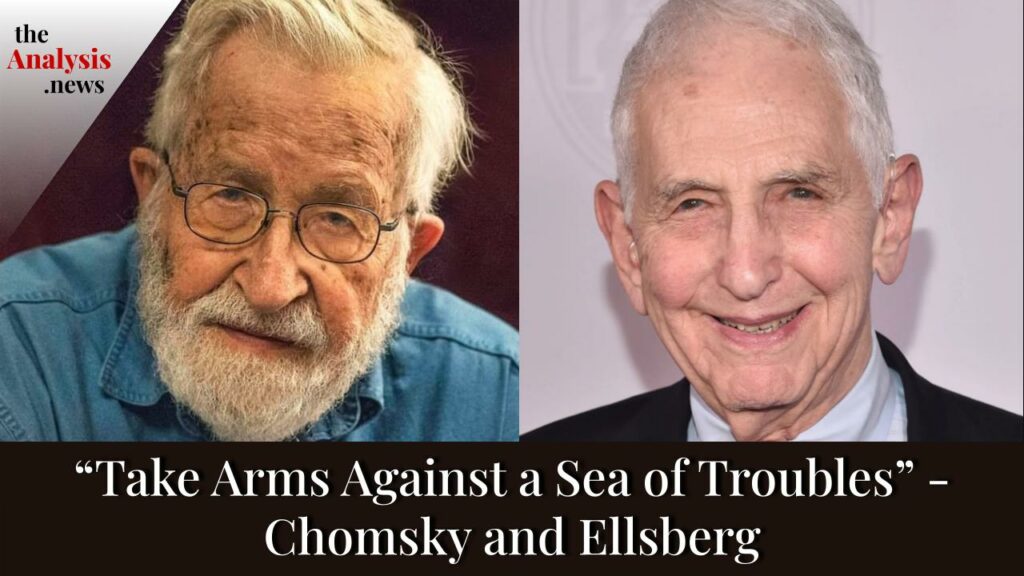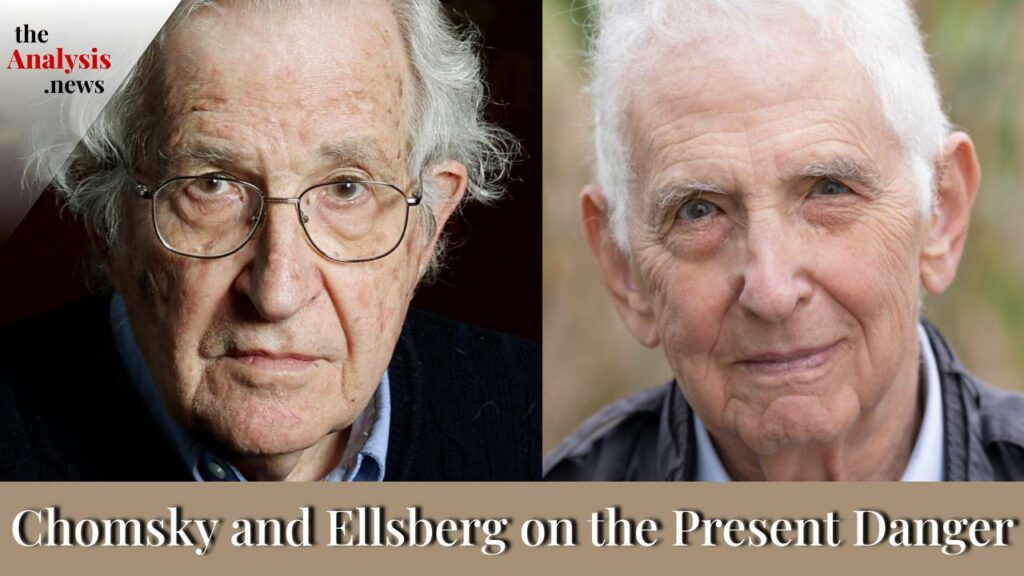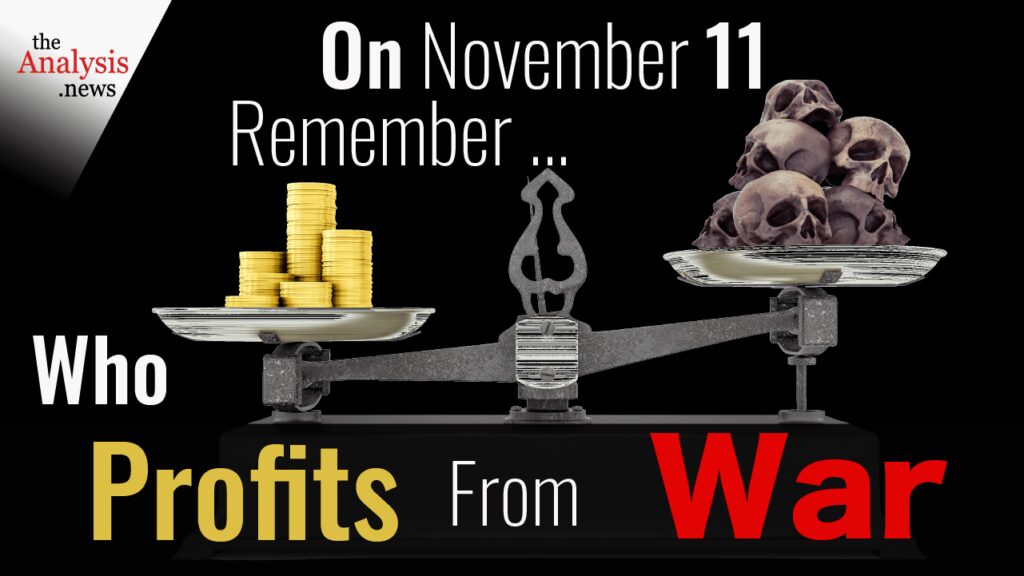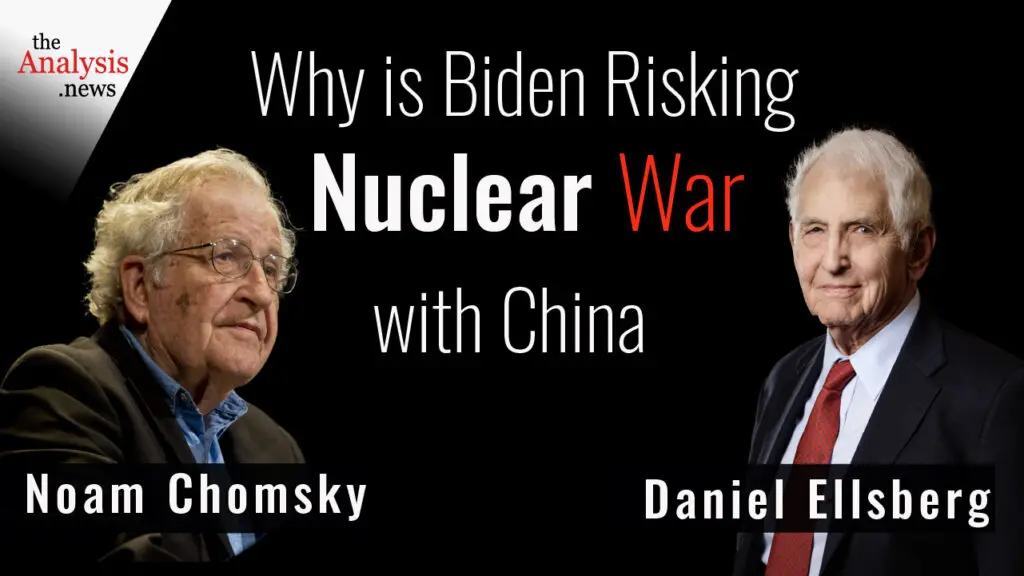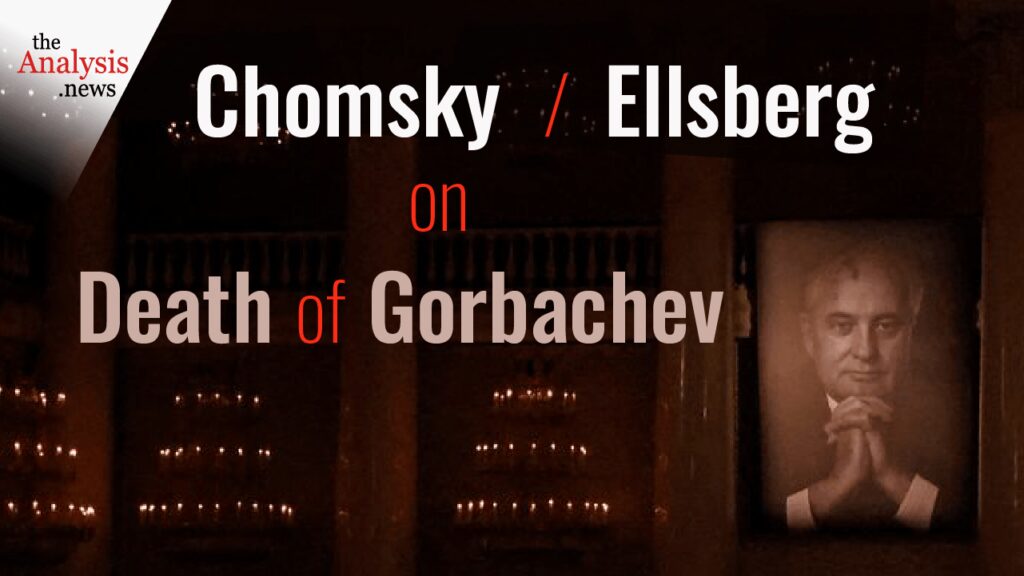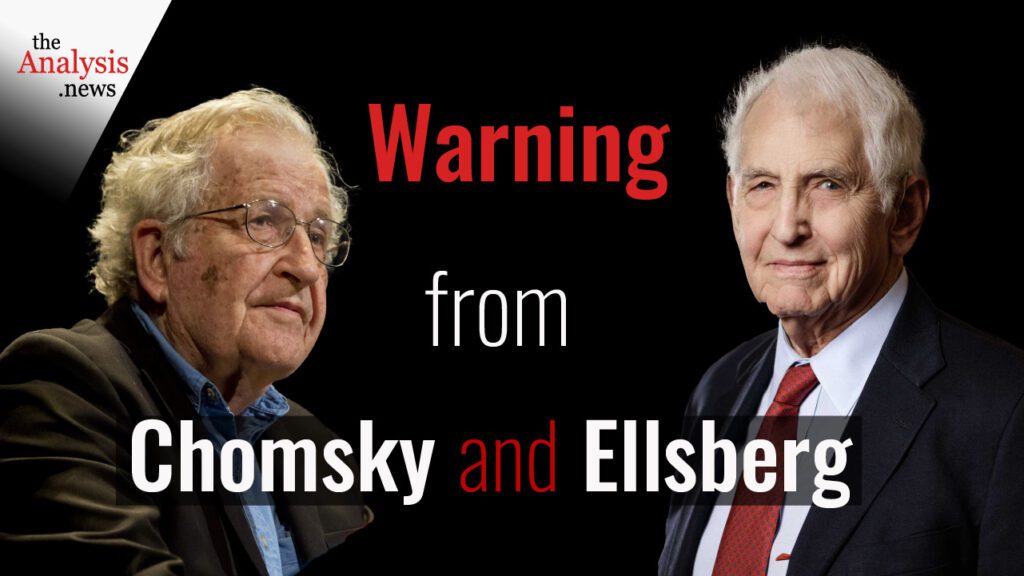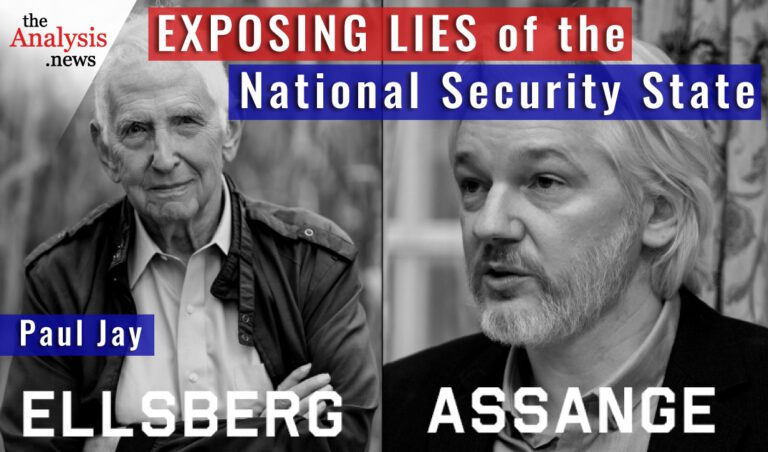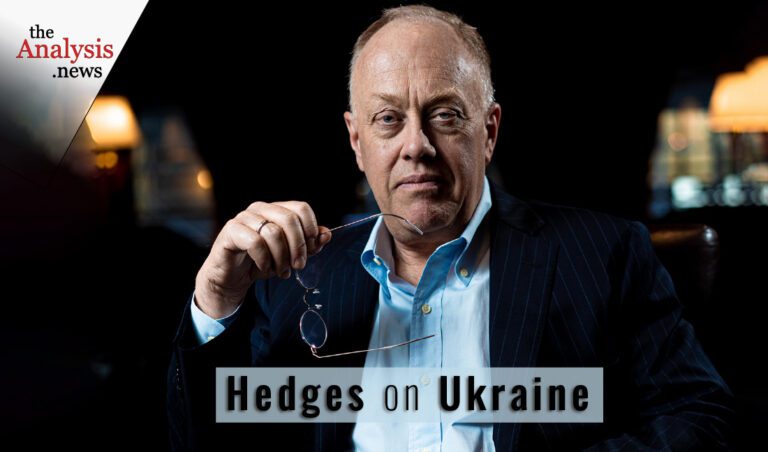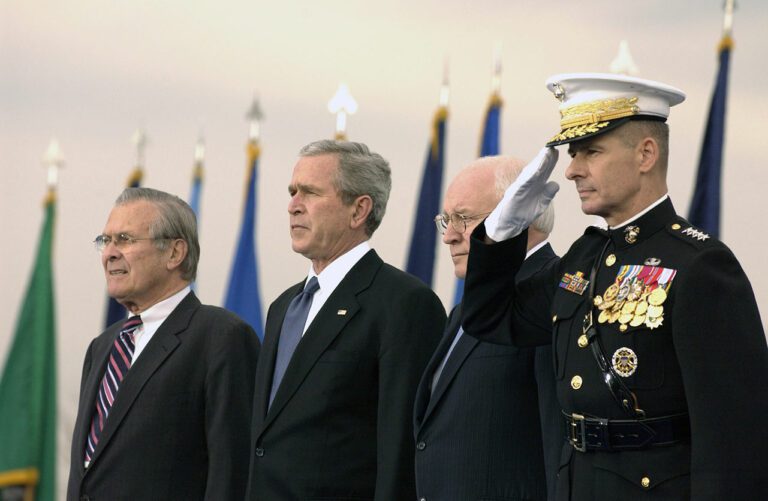On the occasion of the death of Daniel Ellsberg, we republish our interview with historian Peter Kuznick who looks at the significance of Ellsberg’s fight against America’s insane nuclear war strategy, his exposure of the lies of the Vietnam War and his continuing fight against the American war machine.
To view more interviews with Daniel Ellsberg, click here.
Paul Jay
Hi, I’m Paul Jay. Welcome to theAnalysis.news, please don’t forget the donate button and the YouTube subscribe button.
April 7th is Daniel Ellsberg’s 90th birthday. Ellsberg is the original whistleblower. The man who leaked the Pentagon Papers and helped end the Vietnam War. Henry Kissinger called him the most dangerous man in America, but not as we have mistakenly believed for many years because he was about to pull back the curtain on U.S. policies in Vietnam. Kissinger was terrified that Ellsberg was about to reveal an altogether different set of papers. The other Pentagon Papers, ones that would reveal the extent and sheer madness of U.S. nuclear war plans to the public.
Dan Ellsberg was born in Chicago in 1931 after graduating from Harvard in 1952 with a B.A. summa cum laude in economics.
He studied for a year at King’s College Cambridge University on a Woodrow Wilson fellowship between 1954. In 1957, Ellsberg spent three years in the U.S. Marine Corps serving as a rifle platoon leader, operations officer, and rifle company commander. 1959, Ellsberg became a strategic analyst at the Rand Corporation and a consultant to the Defense Department and the White House specializing in problems of the command and control of nuclear weapons, nuclear war plans, and crisis decision making.
His book, Doomsday Machine: Confessions of a Nuclear War Planner, revealed what he called the institutional madness of American nuclear war planning. Edward Snowden said this long-awaited chronicle from the father of American whistleblowing is both an urgent warning and a call to arms to a public that has grown dangerously habituated to the idea that the means of our extinction will forever be on a hair-trigger alert. Ellsberg’s book exposes much of the mythology that was the basis of the Cold War with the Soviet Union and was used to justify the creation of a massive military-industrial complex.
In 1967, Ellsberg worked on a top-secret study with Defense Secretary McNamara U.S. Decision Making in Vietnam 1945 to 68, which later came to be known as the Pentagon Papers. In 1969, he photocopied the 7000-page study and gave it to the Senate Foreign Relations Committee. In 1971, he gave it to the New York Times, The Washington Post, and 17 other newspapers. Ellsberg’s subsequent trial on 12 felony counts, posing a possible sentence of 115 years, was dismissed in 1973 on the grounds of governmental misconduct against him, leading to the convictions of several White House aides and figuring in the impeachment proceedings against President Nixon.
Ellsberg’s release of the Pentagon Papers was an important contribution to the pressure on Nixon to end the Vietnam War. Now, joining us to talk about the extraordinary life of Daniel Ellsberg is historian Peter Kuznick. Peter is a professor of history and director of the Nuclear Studies Institute at American University. He’s the author of Beyond the Laboratory: Scientists as Political Activist in 1930s America. He and filmmaker Oliver Stone co-authored the 12 part Showtime documentary film series and book both titled The Untold History of the United States. Thanks very much for joining me, Peter.
Peter Kuznick
Happy to be with you, Paul.
Paul Jay
So this is Daniel’s 90th birthday, and I have to say he’s still active as hell and still campaigning against nuclear weapons and speaking out on so many issues. I wish I had his energy now, never mind at 90, but let’s start with the issue of Dan’s role as a nuclear war planner and what he has revealed over the years about American nuclear war strategy and the significance of it.
Well, Dan first learned about the possibility of atomic bombs when he was 13 years old from one of his middle school teachers. Before that theoretically, it is possible to make an atomic bomb. This was before Hiroshima and from that point on Dan was very, very worried about the prospect of doing so. Once the bombs were detonated over Hiroshima and Nagasaki, his fears were confirmed. At Harvard, he was actually studying economics and in his graduate studies, he studied decision theory, especially decision making, in a situation where there was a lot of ambiguity, and that’s what his Ph.D. dissertation was on.
He went to work for the RAND Corporation after his years in the Marines because he wanted to work on problems of preventing a nuclear war. You have to remember, he starts really working there in 58, I guess, permanently onboard and 59, and at that point, especially in the aftermath of the Soviets launching Sputnik in late 1957, October of 57 Americans assumed that the Soviets had an advantage in terms of intercontinental ballistic missiles.
The Soviets had actually tested their first ICBM before Sputnik in the late 50s. There was a lot of discussion about the missile gap, the idea that the Soviets not only had an advantage, but they could launch a preemptive strike. You might remember the Gaither Report and the Gaither Report warned that the U.S. is in the worst peril of our existence, that the Soviets could launch a first strike on the United States that could effectively wipe the United States out.
So when Kennedy got elected in 1960, Kennedy had run in part on the basis of this missile gap, which most people believed to be true. Kennedy takes office and he quickly finds out that there is no missile gap, then he gets McNamara to continue the study, and we soon discover that there is a missile gap, but the United States has a vast advantage. The United States is ahead in most categories of at least 10 to 1, in some categories of 100 to 1 over the Soviet Union.
Dan at that point was working on McGeorge Bundy’s staff. Been with the Rand Corporation, was now working with McGeorge Bundy. He was in the Defense Department and he was assigned to do several things that were quite important. One was he wrote the speech for Roswell Gilpatric that basically lays out the reality of the missile gap, one which they admit publicly how far ahead we were, and he saw that as a way to warn the Soviets not to do anything extreme because the United States had this capability, which, of course, Khrushchev already knew, but he also, then for Bundy, McGeorge Bundy, pose certain questions to the Pentagon, which people did not know before.
The main question he posed was how many people would be killed in a U.S. nuclear attack. It was delivered by Bob Komer in the name of President Kennedy, and the Pentagon responded in two parts. The first part talked about how many Russians and Chinese would be killed. The second part talked about how many people overall would be killed, and what Dan then discovered in this response was that the Pentagon estimated that between 275 million and 325 million Russians and Chinese would be killed from America’s weapons.
Then we also found out that 100,000 West Europeans would be killed, 100,000 in the surrounding countries. Overall, the total was going to be 600 million dead from America’s attack alone, which means it’s more than 100 Holocaust’s as a result from America, because America’s plan at that point was to shoot off our entire arsenal at one time. There were no plans for gradation, no plans for a limited response, a gradual response. It was to shoot it all off at once.
So at least 600 million, partly depending on certain wind effects. So that was terrifying to them, and that does not even include the effects of Soviet weapons in their targets in Europe and the United States. Dan at that point did not know about nuclear winter, because he would have realized that almost everybody on Earth would have been killed from that kind of mass detonation, but Dan soon starts to discover other things because he becomes the leading expert on command and control of nuclear weapons.
What he discovers over this period is, first of all, there is no longer just one finger on the nuclear button as people have believed that Eisenhower had delegated authority to the theater commanders to use nuclear weapons if Eisenhower if the president were incapacitated or if they thought it was necessary and they were out of communication, but then had discovered in some of his other studies during this time was that these commanders were out of communication with the White House, the Pentagon often hours a day, partly because of weather conditions, partly because cables got cut.
So this idea that the president was the only one who could authorize the use of nuclear weapons was a falsehood that Dan understood. Then he also understood that Eisenhower gave them the authority to subdelegate this same authority. So if the heads of the numbered armies and air forces, for example, there are others in the field, were out of touch with their commanders and they thought it was necessary to launch, then they had the authority to launch also under certain circumstances.
So what Dan realized is that there was not one finger on the nuclear button. There were probably at least dozens, maybe scores of fingers on the nuclear button. Beyond that it kept on getting worse. Beyond that, he understood that America’s policy at this point, especially in NATO, was to not only threaten to launch, but actually if European countries were being threatened, the United States could launch a preemptive attack against the Soviet Union and later against China.
Paul Jay
Which wipe out much of Europe.
Peter Kuznick
Which would be suicidal and Dan understood the insanity of this. That’s why when he talks about the doomsday machine, he means it quite literally. He means that there are the rational, thinking people behind our nuclear strategy, which was the heart of our defense policy that we built up into this vast machine, because you know, and I put a lot of this in Untold History, much of which I learned from Dan, and that when Eisenhower took office, we had approximately a thousand nuclear weapons and they were in the hands of the civilians, but Eisenhower quickly starts transferring them to the military control, and when Eisenhower was budgeting cycle is finished now, not even his budget cycle, his presidency is finished in January of 1961.
We now have no longer a thousand. We now have close to 23,000 nuclear weapons. When Eisenhower was budgeting cycle just finished, the U.S. has 30,000 nuclear weapons. So Eisenhower’s warning about the military-industrial complex was not a metaphor and it’s not an abstraction. Eisenhower knew this because he created the military-industrial complex for the crazy reason that he was afraid that by unbalancing the budget that we would run this huge deficit and that would wreck the American economy.
He thought that nuclear weapons were cheaper than conventional weapons, and so he downplayed the army try to control the defense budget and to do so with the cheaper means of defending the United States with nuclear weapons, but it’s the beginning of this total insanity, which consists to this day and that’s what Dan’s dedicated his life to, combating. The reality is that we’ve created this insane doomsday machine. It’s not only irrational and indefensible, it is suicidal.
Paul Jay
And so much of this nuclear war mythology, which the missile gap is one of the big pieces of, is a foundation of the whole rationale, justification for the military-industrial complex and so much of it is just bullshit. And apparently Kennedy was told this while he was campaigning for president. Is that true? He was told there really wasn’t a missile gap, but he keeps saying it as part of his election campaign. Is that right?
Peter Kuznick
I don’t think so. Allsopp was the one who was advising Kennedy on this, and the numbers he was giving him were totally insane, but also the same thing with the demands from the Joint Chiefs of Staff, you know, and the strategic command, they wanted 3000 more ICBM’s, McNamara said the lowest number he could convince them to accept was the increase of a 1,000 ICBMs. How did that look to the Soviets? How did that look to the Kremlin?
They knew that the United States had a vast superiority ready and its saw the United States was going to add a thousand more intercontinental ballistic missiles to the arsenal. In the Kremlin, they were convinced that the United States was preparing for a first strike, that there’d be no other reason if they had such a vast superiority already to massively increase the number of ICBMs unless they’re preparing for strikes.
Paul Jay
And they were.
Peter Kuznick
Well, they had plans to do so. Kennedy thought it was absolutely insane when Kennedy was briefed upon this, he commented to Dean Rusk “and we call ourselves a human race”.
You know, Kennedy hated this as did Khrushchev, and we’re very lucky. Kennedy once said, I’d rather my children be red than dead, the opposite of Eisenhower, who said I’d rather be atomized than communized, and if Eisenhower had been in office during the Cuban missile crisis instead of Kennedy, we wouldn’t be here today having this discussion. Had Barack Obama been in office instead of Kennedy, we wouldn’t be having this discussion. We are lucky that probably the only president who would have resisted during the Cuban missile crisis, any president we’ve had since Roosevelt was Kennedy.
Paul Jay
All right. Let’s hold the Obama peace, because that’s rather interesting and we’ll get to that. My understanding is in this period, which I guess is around 1960 or just after Kennedy gets elected, that the Army and Navy were saying that the Soviet Union might have had 100 to 200 ICBMs. But the Strat, the Air Force Strategic Air Command, led by Curtis LeMay, who’s the guy who firebombed and nuclear bombed, Japan, he was telling the White House and others that the Soviet Union might have a thousand ICBMs, and then Ellsberg finds out that the actual number is four and that that changes his whole head. He describes himself as quite a militant cold warrior up until that point.
He was a cold warrior from the beginning, as was his father, who was a lifelong Republican and Dan did think that the Soviet Union was the enemy and they had to be resisted. He initially thought that the threat of nuclear war did not come from the United States. The danger of nuclear war came from the Soviets, and so his initial strategy was, what do we have to do to preempt a Soviet nuclear attack on the United States?
So the missile gap is relevant in that context, and he discovers, as you say, that the United States has 40 ICBMs. The Soviets only have four, initially, at the time of the Cuban missile crisis, the gap was even much faster than that. So Dan discovers that early and that’s starting to change his thinking and that original psyop that he studied where the United States is going to launch everything and lead to about 600 million deaths, lrther reinforced his thinking on this.
That was Dan’s initial interest, as a nuclear war planner when he went to work for McNamara in the Pentagon in 64 and he started to work on Vietnam, but his real concern was with nuclear war and how to prevent nuclear war, and a lot of this concerns about Vietnam are, again, in the context of preventing nuclear war.
Paul Jay
Well, elaborate that.
Peter Kuznick
Well, it was interesting. The more studying I did on this period, the scientists especially, the Chinese test their nuclear bomb in 1964, and so the American strategy in Vietnam is even back in 54 when the French were being defeated at Dien Bien Phu. According to Operation Vulture, Nixon and John Foster Dulles offered the French three atomic bombs to use against the Vietnamese at Dien Bien Phu.
Paul Jay
OK, hold on. The Americans offer the French nuclear weapons and in other words, suggesting they should.
Peter Kuznick
Well, yes, the United States and Nixon thought so. Eisenhower thought so and others thought so, but they wanted to get the agreement of Britain and France before they would do this. And the British and the French, fortunately, were much more rational than was Eisenhower and Nixon at that point. You have to remember that Eisenhower, his goal was to erase the line between nuclear weapons and conventional weapons. He said this taboo is limiting what we can do.
But American policy by 54, the New Look defense policy was to rely on nuclear weapons in our first line of defense. This is one of the insanities of Eisenhower. Eisenhower was not a warmonger. He’s not bloodthirsty, but his policy was suicidal or as Dan likes to say, a homicidal policy, and we knew that from the mid-50s. That’s why in 1955 that Bertrand Russell and Albert Einstein issue their famous Einstein Russell Manifesto. The last thing that Einstein ever signed was the letter to Bertrand Russell signing on to this manifesto.
And what it says basically is that if there was a nuclear war and London and New York and Moscow were wiped out, that within a few hundred years the human species would recover, but the real danger in a nuclear war with hydrogen bombs is that all of humanity would be wiped out, and so that’s their warning. They and I think it was nine other leading physicists and philosophers around the world signed off on this and Dan was aware of this, but thought that the real threat at that point was coming not from the United States, from the Soviets, which he learns later is not the case.
But Einstein’s nuclear policies. It was back in 1947 that Lewis Mumford wrote that editorial, that statement, gentlemen, you are mad. That these look like normal human beings going to the office with families and children and dressed in suits and ties with the name of president and secretary of defense and general. He says they go to the office and they carry out these plans for annihilation, for human extinction. They’re madmen, you know, but it’s been rational people with rational plans who seem like normal human beings who are bent upon this compulsion for mass extinction, and that’s the craziness that Dan has been campaigning against his entire life ever since. This makes him, you know, why we love him so much.
Paul Jay
And when he releases the Pentagon Papers, his plan is to reveal all this insanity about nuclear strategy, and then the documentation gets wiped out in a hurricane because it was buried somewhere.
Peter Kuznick
Dan had not only copied the Pentagon Papers, he had copied everything else that was top secret in his desk at Rand, and so he had thousands and thousands of pages on all of America’s insane secret war plans. Our nuclear war plans. Dan thought that after the Pentagon Papers crisis was over, he was going to then release all of the nuclear papers, and that was what he thought was even more important than the Pentagon Papers about the Vietnam War.
But he knew that the FBI was going to come and arrest him because of the Pentagon Papers leak, so he gave these other papers to his brother, his brother Harry, an older brother, and his brother also realized that when Dan got arrested, he was going to come and search his place. And so he put them in a cardboard box inside of a green plastic garbage bag, then decided to bury them in the local dump and he buried them under a stove so it could be identified where they were and can get them again when he was ready to.
But then there was a tropical storm that summer and all of the things in that dump got misplaced. The stove was 100 yards away from where it was originally, and they couldn’t find all the nuclear papers, and they searched for a year and a half and they got all kinds of digging machines and everything and got thousands of bags, but not the right ones, and so they never found it and never found all these. Since then fortunately, a lot of them, or some of them at least have been released and declassified. One of the things about them, he might not remember when you and he talked about yesterday. He has a photographic memory of every document that he ever saw 60 years ago.
So in Dan’s brilliance, you know, came in number three in his class at Harvard, and Kissinger, who describes him, as you said, for being the most dangerous man in America, had publicly given him credit for having taught me more about Vietnam than any other living person, and that everybody recognizes Dan’s brilliance.
And going along with that is this precise photographic memory when it comes to all the things that happen and the documents. He was able to recreate a lot of this over the years.
Paul Jay
And this ends up in his book Doomsday Machine. And I should, for all transparency’s sake, explain that I’m working with Dan on a documentary series on exactly that book on Doomsday Machine.
So. How does a man who’s a Marine? Who’s a cold warrior. Who’s life up until this point is devoted to the military-industrial complex. How does he get to a point where he releases the Pentagon Papers, is ready to release the nuclear secrets, and willing to go to jail for it?
Peter Kuznick
Well, Dan had a deep sense of morality, fortunately for the world. And he also had an abhorrence for lies, mendacity, and deception. He’s really a democrat a small d democrat and believes that people and policymakers need to have access to information. Dan believes in transparency, believes in honesty, believes in decency, and has an abhorrence for war and killing. And so when he saw that firsthand, when he talked about Vietnam, he went to work in 1960 for his first day at work for MacNaughton in the Pentagon was August 4th, 1964.
And that was the day the Gulf of Tonkin incident, and he saw what was happening and he saw that initially, they thought there was an attack, but as more and more intelligence came in, they realized that it was very dubious that there was any attack.
Paul Jay
Peter, for younger viewers that don’t know what we’re talking about, just a quick 20 seconds on what the Gulf of Tonkin incident was.
Peter Kuznick
The Gulf of Tonkin incident was U.S. ships, two U.S. ships in these waters off the coast of Vietnam had allegedly come under attack, and the belief from the North Vietnamese and the belief was this was aggression on the part of North Vietnam in response to which the United States launched attacks on North Vietnam. This was August 4th, 1964, but it very quickly became clear that from the commander on board the USS ships there, that there were all kinds of interference, that things that they thought were an incoming attack were not an incoming attack.
But we decided to launch this anyway, and McNamara and Johnson issued a series of statements that were baldfaced lies about what had occurred that night and the intelligence was coming and Dan realized beforehand that it was very, very dubious and that they were using this as a pretext for escalating and expanding the war in Vietnam. To give it a little more context, Dan and McNaughton, his boss, were asked to come up with a series of statements that were basically a series of lies that could be used in defense of American policy of aggression there.
That was Dan’s first day and first night. He stayed up all night in the Pentagon working on this, following the incoming intelligence reports. So Dan effectively shifted when he went for MacNaughton in August of 64 from the nuclear issues to Vietnam, and so he started to get all the intelligence reports. He asked for everything, and every day they would bring in a stack of reports taller than he was. So eight feet of reports, mostly top-secret reports about what was going on in Vietnam.
So Dan had a front-row seat to the lying, the mendacity. You have to remember that during the Johnson administration they developed the term called the credibility gap because Johnson would. You know, we talk about Trump and Trump’s seven-plus thousand lies about everything. Johnson might not have been quite the pathological liar that Donald Trump was about everything. When it came to Vietnam Johnson lied constantly. And among these things. That Dan was discovering during these years, because he goes to Vietnam first in 1961, goes back to Vietnam in 1965, and there he is working for the infamous Ed Landsdale, the master counterinsurgent, there.
And he becomes friendly with John Paul Vann, who is a very honest critic of the war, and then Dan is in charge of doing assessments of the pacification programs in the countryside. He stays in Vietnam as a civilian until 1967. Then he gets hepatitis and has to return to the United States. So between the documents he was reading and his on-the-ground experience, Dan was learning firsthand, was that what we were saying about the war and the reality of the war were two different things.
Then in 67, Dan is asked to work on the Pentagon Papers, which was a secret study of the war from 1954, even earlier up through 1968. That was commissioned by Secretary of Defense Robert McNamara. Dan had worked through Rand on the first volume, but he actually got access to the entirety of this top-secret document that he stored in his safe at Rand. So what Dan was learning over these years was that we were saying that not only could we win the war, which was not true, but that we were winning the war.
And for example, when Dan was in Vietnam, he met with McNamara in 66 and he briefed McNamara. McNamara wanted to know what Dan was finding on the ground and Dan told him that we were not only not winning, that we were losing ground. That is the best we could say. It was a stalemate, a quagmire. The worst was we were putting more and more troops in and getting nowhere, and McNamara agreed with him and he said that the situation is worse.
It’s much worse than it was a year ago, and then McNamara gets off the plane, gets in front of the microphones, tells the press and the others who were there, we’re winning the war. Things are improving. Conditions are getting better. Dan saw first hand that kind of lying, repeatedly, as did others. There were at least a thousand people Dan said who knew the reality was the opposite of what was being said. And what was being said? We were winning. In reality we were not. So when Johnson talks about putting in another twenty-five or fifty thousand troops and he says, and that’s all we have planned, the generals and Dan and others knew that they had plans to put in one hundred and fifty thousand more troops, but they were lying to the American people. They were lying to the Congress and that this is not the way a democracy is supposed to work. So Dan understanding the horrors of what we were doing, the futility of what we were doing, the immorality, and the mendacity, Dan knew he had to do something.
So his thinking was changing, and he met Patricia, who he is madly in love with and Patricia was covering the war as a journalist and also helped influence Dan. They went to anti-war marches together and Dan knew that he had to act and figure out ways to act. So he told everybody he spoke to that this is wrong, it’s immoral, it’s a lie, that we’re actually not going to win and we should get out immediately. He was opposed to the bombing.
He hated the thought of the bombing. He hated the troop escalation and knew that this was a losing policy and we were lying to the American people. So then he works on the Pentagon Papers and by 1969, he’s at his wits end about what to do to try to help end the war. So Dan decides to copy the Pentagon Papers. This is two years before they were released, and then Dan tries to get them to congressmen, to senators.
He tries to get to friendly people, to Robert Kennedy. He wants Charles Mathias, Fulbright, other senators, to get them to release this publicly, put it the congressional record, go before the public and say that we’ve been lying and lying and lying, but everybody’s got their reasons for not doing it. So finally Dan decides that the best way to do it is to go to The New York Times. He contacts Neil Sheehan because he knew Neil from Vietnam.
He knew that Neil was strongly opposed to the war and so he trusted Neil Sheehan and gave him access to these records, the Pentagon Paper because what the Pentagon Papers showed is that administration after administration after administration had been lying about the war and that the public didn’t know this and much of Congress didn’t know this. Dan thought that leaking the Pentagon Papers would probably not end the war, but it might help nudge the country in that direction.
And so finally, even though Neal was playing dirty and dishonest with Dan about what The Times was planning, The Times, finally, I think it was June 13th, 1971, finally starts publishing the Pentagon Papers. They didn’t even give Dan any warning that they were going to do so, which was very, very immoral. It was not hard to figure out that Dan was the likely source for this. The FBI was already onto him for this.
Dan and Patricia, go underground. Part of the story that’s not very well known is that the papers were for a time stored in Howard Zinn’s living room in Boston and working with Dan to distribute them to the newspapers was my friend Gar Alperovitz, who wrote the book Atomic Diplomacy, which really was one of the great books about the atomic bombing of Hiroshima. And Gar is still very, very active through Democracy Collaborative and other things on nuclear issues and on economic transformation.
Gar is still out there doing great work, but his role in all this didn’t come out until a couple of years ago. So they get it to The New York Times. The Times starts publishing it. The Nixon administration freaks out and they get the Supreme Court to issue an injunction on The New York Times to halt publication. And so Gar then brings them to The Washington Post and then The Washington Post starts to publish and then The Boston Globe.
So then The Post is shut down and the Boston Globe and then The Globe is shut down and the St. Louis Post-Dispatch and they’re shut down.
Paul Jay
Shut down by injunction from the government
Peter Kuznick
Yes to stop the publication. They finally get it to 19 different newspapers that are publishing parts of this and the Supreme Court lifts the injunction and says that they do not have a right to stop the publication.
Paul Jay
Now, what’s the historic significance of the release of the Pentagon Papers and how much did it have an affect on eventually ending the war?
Peter Kuznick
Well, it’s interesting because Nixon and Kissinger freak out and if you watch Oliver’s movie, Nixon’s got a lot of this and they decide that they’re going to destroy Dan Ellsberg, right? Nixon says, we’re going to show him going to the bathroom in front of the American people and we’re going to destroy him, and in those meetings there, Kissinger apparently mouthing Colson, talks about different things about Dan, all these lies, but then he says that Dan Ellsberg is the most dangerous man in America as you said in the introduction.
Dan had known Kissinger at Harvard. He had lectured in Kissinger’s classes a couple of times. Kissinger had tremendous respect for Dan, but Kissinger was such a slimy and duplicitous, two faced lying, kind of power hungry creep in all of this. So then they create the plumbers unit. The plumbers unit was set up to stop the leaks and the leaks were coming from Dan initially, but it was the things that they did to Dan that ultimately bring down the Nixon administration.
So the plumbers unit, they also wiretapped Dan’s phones illegally. They broke into his psychiatrist, Dr. Fielding’s office to get more compromising material. They put a hit on Dan of 12 Cubans from the CIA who go back to the Bay of Pigs, who are told to compromise Dan totally, to incapacitate him totally, is what their objective was. Fortunately, they didn’t get to him that day, but it was those things that ultimately brought down the Nixon administration.
A lot of the other things in Watergate, Nixon could have probably defended himself against on national security grounds, but they found all of these other things. It was based on that. So when the trial finally comes in 1973, Dan and Tony Russo faced one hundred and fifteen years in prison for what they had done under the Sedition Act or the Espionage Act of 1917. They prosecuted Dan and he was facing 115 years. A life sentence for trying to stop the Vietnam War.
But it ultimately happens is this is what brings down the Nixon administration, which is fortunate because Nixon intended to restart the bombing, but because of the Watergate investigation and scandal, he wasn’t able to do so, and we were finally able to end that war. The American part of it, in 1973, the overall war in 1975. The war, as you know, was horrific. Robert McNamara came into my class. He said he accepts that 3.8 million Vietnamese died in the war.
As I say, and I think you and I have discussed that, I ask my students, what they know and they don’t know that much about it, but they have almost all been to the Vietnam Memorial walls and those black granite walls, marble, two big walls, 492 feet long have the names of fifty-eight thousand two hundred eighty Americans who died in the war. The message of the Vietnam Memorial is that the tragedy of Vietnam is that fifty-eight thousand two hundred eighty Americans died 492 feet long.
If those walls contain the names of all the Americans, all the 3.8 million Vietnamese, the more than a million Cambodians, Laotians, the Thais, the Brits, the Aussies, everybody who died in that war, it would be more than eight miles long, and that’s what should be the memorial to the Vietnam War. And that would be an anti-war memorial like the Okinawa Memorial that has the names of everybody on all sides who died in the fighting in Okinawa, but the Americans are not quite there yet, but Dan was there. He saw the tragedy and was willing to risk his life in order to stop that war.
Paul Jay
Now, Dan is, as I said early on, is still as active as ever campaigning against the threat of nuclear war, and he says he thinks the threat is as dangerous now as ever. This idea that because the Cold War with the Soviet Union’s over somehow nuclear weapons aren’t a threat anymore is a complete illusion that it’s still very dangerous.
So let’s talk about the current situation, but start with the comment you made about Obama, that if Obama had been president during the Cuban missile crisis, we might not be talking today.
Peter Kuznick
Well, the thing about Kennedy was that from the Bay of Pigs on. Kennedy had been sort of a war hero in World War Two in the Navy, and after the Bay of Pigs, he refused to send reinforcements to back up the bomb in Cuba and he had told them beforehand he wouldn’t, but he got berated by top officials in the Pentagon, Lemnitzer and the CIA, who thought that under that pressure, Kennedy would have to cave in and send in the military support for the invading Cuban exiles and CIA exiles in the Bay of Pigs, and he refused to do so.
After that, he developed this deep mistrust and he talks about later those CIA bastards, those Joint Chiefs, sons of bitches. He said the first advice I’m going to give my successor is don’t trust the generals. Even on military matters, they don’t know what they’re talking about, and he says at one point, if somebody comes in here and they want to talk to me about economic policy or an insurance issues, he said, I have no trouble contradicting them, but you assume that the military and the intelligence people have the superior knowledge and insight. They don’t. You can’t trust them even on these things. So Kennedy had a deep mistrust, and during the Cuban missile crisis, he was often the only one in the room who resisted bombing and invading Cuba, and that’s why I’m saying that Obama, I’m not saying Obama is a bad guy or was bloodthirsty.
It is bizarre that he won the Nobel Peace Prize while fighting two wars and bombing multiple other countries, but Obama just never stood up to the generals that way. Obama just did not have the backbone. Obama gave in time and time again, even though he knew, I’m sure that this was a mistake. But then, and I know, perhaps more than anybody, have been making an issue of the fact that we’ve known since 1983, but the reality is since 1950, 52 probably we’ve been living with the threat of a nuclear winter and that Sagan and the other scientists publicized this in 1983 and they talked about what would happen in the event of nuclear war in which the cities would burn and the cities would burn, and that would send up millions of tons of smoke and soot into the stratosphere.
If it was in the troposphere they would get washed away, but in the stratosphere they wouldn’t, and within weeks it would circle the entire globe, and soon block seventy percent of the sun’s rays from hitting the earth, the temperatures on the earth would plummet, agriculture would be destroyed. We have about a 60-day stockpile of food around the world. And after that, the starvation and disease would begin and that perhaps not everybody on earth would be killed, but over a period of years, probably 90 to 99 percent of people on earth would perish as a result of what we call nuclear winter.
And I’ve been working with people to expand these studies now, and what we realize now is that, if anything, the threshold for nuclear went that Sagan and others were talking about back in the 1980s was too low, that even though there were scientists paid by the defense contractors and others who tried to deprecate and deny the theory of nuclear winter at that point say, well, maybe it’s only nuclear autumn and it’s exaggerated and that not everybody would die.
The same kind of attacks by, quote-unquote, scientists against carcinogenic effects of nicotine. The effects on the ozone layer that we see now about climate change, the same kind of lying refutations happened in the 1980s against nuclear winter, but scientists have begun doing those studies again. What the recent studies show is that the risk is even greater than we realize. The recent studies show that a limited nuclear war between India and Pakistan, in which 100 Hiroshima-sized nuclear weapons were used, that that limited nuclear war, which would kill up to two billion people all over the planet because of partial nuclear winter.
And we know the reality is not that there are 100 nuclear weapons, there are close to 14,000 nuclear weapons left, and they’re not Hiroshima size. They’re between 7 and 70 times the power of the Hiroshima bombs. So we know that we’re lucky, and this what Dan has been warning about more eloquently than anybody. This idea that we’re still living with insanity, with the threat of annihilation, with the doomsday machine that we’ve created, and that if we created it, we can dismantle it.
We’ve gotten rid of 80 percent of nuclear weapons, maybe more than that, but the United States and Russia have more than 90 percent of the existing arsenal and that many of them, a couple of thousand of them are pointed at each other on hair-trigger alert, and that’s the first step of the insanity. Get rid of those intercontinental ballistic missiles, stop planning for a new generation of intercontinental ballistic missiles to replace the Minuteman 3. Dan wants to do that.
He wants to get rid of the first use policy and replace it with no first use. Obama was supporting no first use back in 2013 and did want to eliminate America’s first use policy, but he got pushback and he got pushback from our NATO allies. He got pushback from countries like Poland. And he said, well, if we get rid of our first use, then Japan is going to develop its own nuclear weapons and Poland is going to develop their own nuclear weapons.
And so we can’t do it, and again, Obama didn’t stand up and fight for that. So, you know, Obama was a decent guy in a lot of ways and knew better. He just did not have the backbone of a Kennedy when push came to shove at that kind of crunch time, and now Biden, you know, as much as I admire much of what Biden is doing when it comes to domestic policy and his pro-labor stand and some of his economic policies, his new infrastructure plan might not be as big as I would like or his pandemic plan, but he’s on the right track on these things. When it comes to foreign policy he’s sadly, I think on a very, very dangerous track right now.
Paul Jay
And there’s a new nuclear arms race, the Americans, the Russians and now the Chinese, apparently a whole new generation of nuclear weapons, at least a trillion dollars being spent by the U.S. and Russia, and one expects that China, which has been a bit more moderate on these issues, may not continue to be so, and we’re back into the crazy nuclear weapons race with all the promise or possibility of accidents, never mind deliberate use.
Peter Kuznick
And that was Obama’s plan. That was the corrupt bargain that Obama made, and he authorized a trillion-dollar modernization program over 30 years.
Paul Jay
It’s been reported that Biden was opposed to but there’s not a pipsqueak out of the Biden administration now of undoing it.
Peter Kuznick
And then during Obama’s time, they estimated it was at least $1.2 trillion. Now, the estimate is that it’s going to cost at least $1.7 trillion, and the craziness is that it’s not just the U.S., that every single nuclear power. All nine are modernizing their nuclear arsenals to make them more efficient and more deadly.
By more efficient means single weapons can kill more people. I don’t know why I’m laughing.
Oh, it’s not laughing out of it being funny, it’s laughing out of desperation. When we feel helpless, sometimes we laugh, but look at what’s happening. March 1st, 2018, Vladimir Putin announces in his State of the Nation address, he announces that Russia now has five new nuclear weapons, all of which can circumvent the American missile defense. After the US abrogated the ABM Treaty back in 2003, the Russians began and they now finally have succeeded, and we’ve got all kinds of crazy new weapons that the U.S. says Russia has China has. Hypersonic fly vehicles, new kinds of cruise missiles, torpedoes, underwater torpedoes that can blow up coastal cities.
It’s getting more and more insane is what we’re having, and you mentioned China. China has a relatively small arsenal. China understands that 200 to 300 nuclear weapons is a sufficient deterrent, to wipe out the United States and every place else you might ever need to. That you don’t need 10,000 or 4000 or 1000 nuclear weapons.
Paul Jay
There’s a scene in Blazing Saddles where the sheriff has a prisoner, a black sherrif has a white prisoner. And he takes the gun and puts it up to his own head and says, if you take one more step, I’m going to shoot. The thing is, that’s almost the way nuclear winter works. The Chinese don’t have to hit the United States. They just have to threaten to blow themselves up, and it’s the end of the human race, and none of this is getting through in terms of the media.
And none of it’s getting through in terms of the Biden administration, really, either. Biden is being asked, how is he going to pay for his new trillion-dollar infrastructure plan? One good way to start would be to cut the Pentagon budget in half and the Department of Energy budget in half.
Paul Jay
Well, there’s a bill that Senator Markey and Representative Ro Khanna have introduced to stop this new ICBM development and put it into Covid relief. At least that’s creating a conversation, but you wouldn’t know much of it. The mainstream media has barely covered the fact that they’ve introduced this bill.
Peter Kuznick
One of the discussions we’ve had in recent years that no single person. You know, right now, Vladimir Putin and Joe Biden, have the power to end life on the planet. I mean, they both have their own doomsday machines and they both can trigger a nuclear holocaust, and nobody should have that power. Actually within Russia. He’s got to get sign-off before he would launch from, I think, two other people, but Biden technically doesn’t. If Biden gives the order to launch a nuclear attack now, nobody can stand in the way. Nobody can stop that, and that is pretty crazy, too, but the sad reality, and we don’t know for sure, but we’re pretty sure is that there are other people, again, with their finger on the nuclear button. One of the things that Dan warned about in the 60s is that there were no locks on nuclear weapons.
So even though people might not have had the authority, every submarine commander had the power to wipe out the Soviet Union, pilots had the power to launch themselves. We see the Strangelove scenario where a rogue, crazy general launches against the Soviet Union. That was the reality. We don’t begin to put the locks on weapons in Europe until much later. I gave a talk in which I’m talking about this, and finally, somebody from the audience, one of the generals, comes up afterwards and says that he used to carry the nuclear football.
And by the 1980s, we finally did put locks on submarine-launched missiles, but for or decades people could do this even if they didn’t have the authority technically to do it, and we think that there has to be redundancy now. That if people are out of touch with the White House, other people can still launch without the president’s authorization or what happens when Reagan gets shot during that time and certainly others can. George H.W. Bush could have launched during that time.
Paul Jay
Well, for any of the viewers watching that, haven’t seen the movie, Dr.. Strangelove, go watch it right away and know, because this is out of Dan’s book, The Doomsday Machine, that when Dan and a friend of his went to see the movie, they came out and one of them turned to the other and said did we just see a documentary, because they actually believed that the scenario was really quite possible, and then definitely everybody go out and get Dan’s book, The Doomsday Machine.
It’s a compelling read, chilling, and for me, one of the most important books I’ve ever read because I was like everybody else, I was in nuclear war denial.
You know, I could get climate and this and that, but nuclear war seems so abstract. When you read that book. It won’t seem so abstract anymore. Anyway, thanks very much for joining us, Peter, and happy birthday, Dan.
Peter Kuznick
Happy birthday, Dan.
Paul Jay
And thanks for joining me on theAnalysis.news. Don’t forget the donate button and all the rest.
Podcast: Play in new window | Download | Embed
Subscribe Apple Podcasts | Spotify | Android | iHeartRadio | Blubrry | TuneIn | Deezer | RSS
Never miss another story
Subscribe to theAnalysis.news – Newsletter
“Peter Kuznick, Professor of History and Director of the Nuclear Studies Institute at American University, He and Oliver Stone co-authored the 12-part Showtime documentary film series and New York Times best-selling book both titled The Untold History of the United States (Simon and Schuster, 2012, 2019). The documentaries are now available on Netflix. He has also co-authored (with Akira Kimura), Rethinking the Atomic Bombings of Hiroshima and Nagasaki: Japanese and American Perspectives (Kyoto: Horitsu Bunkasha, 2010) and written several other books on scientists and politics, Cold War culture, U.S. empire, and nuclear history.”



